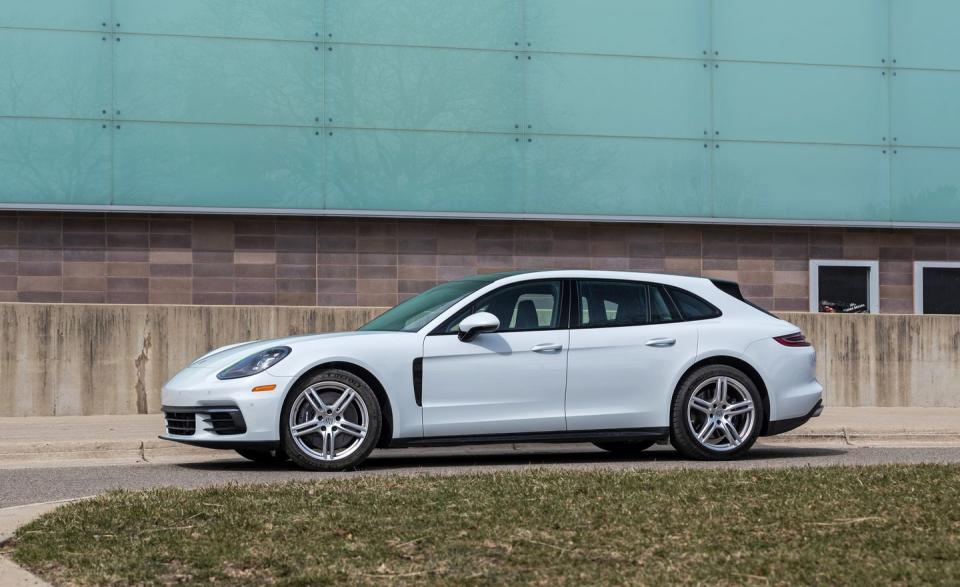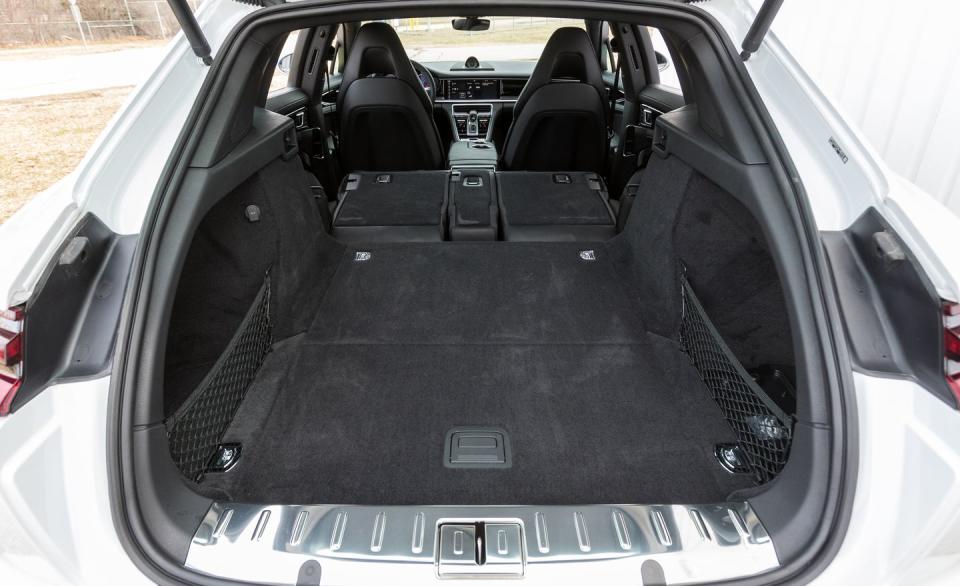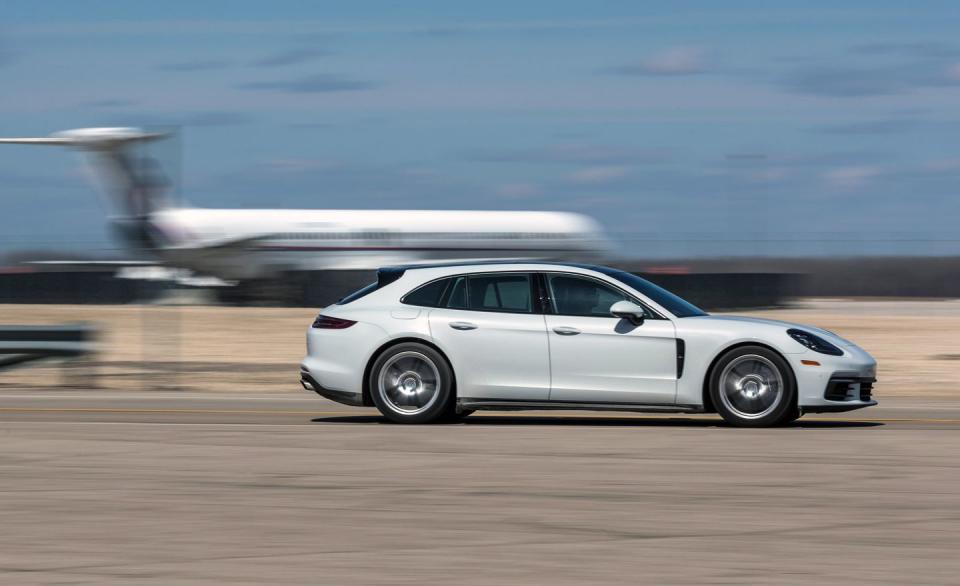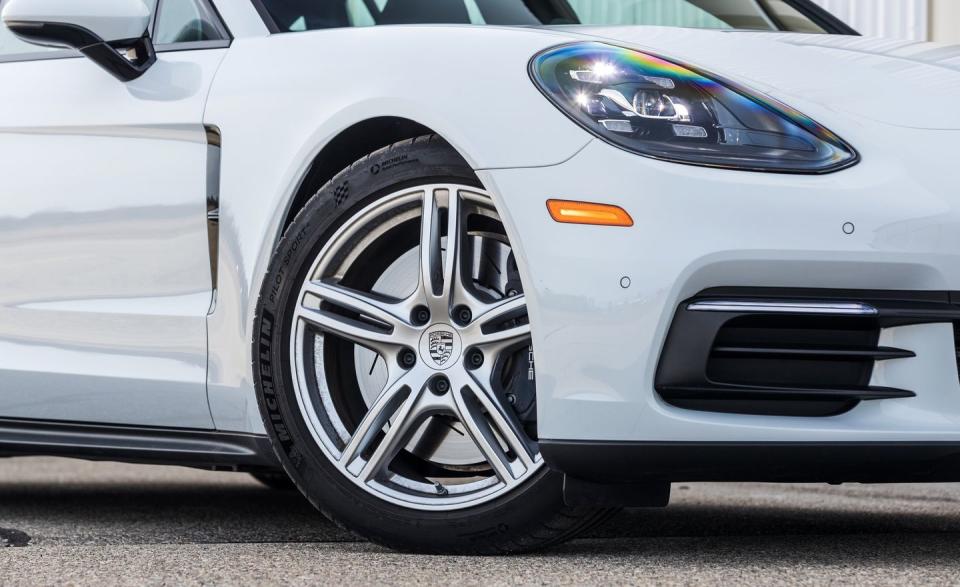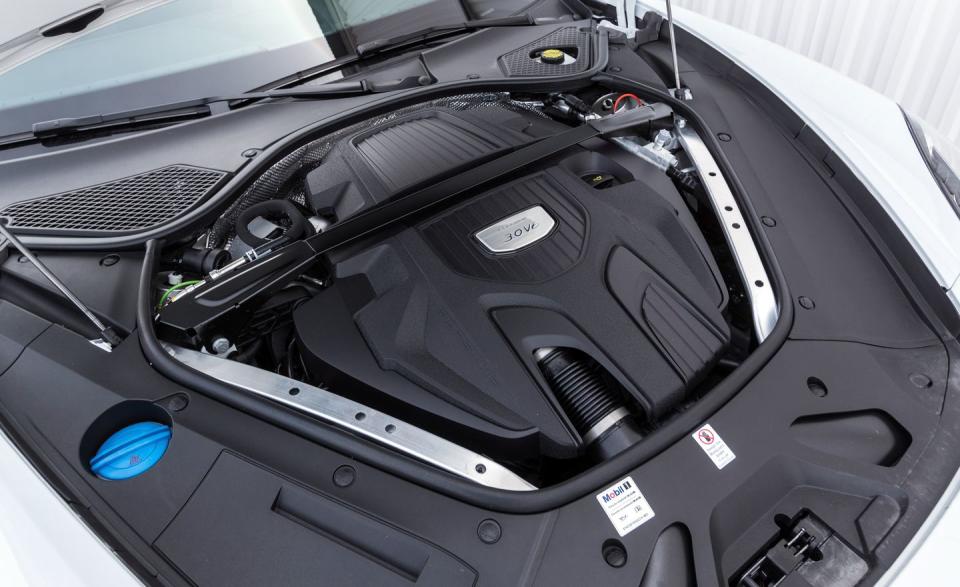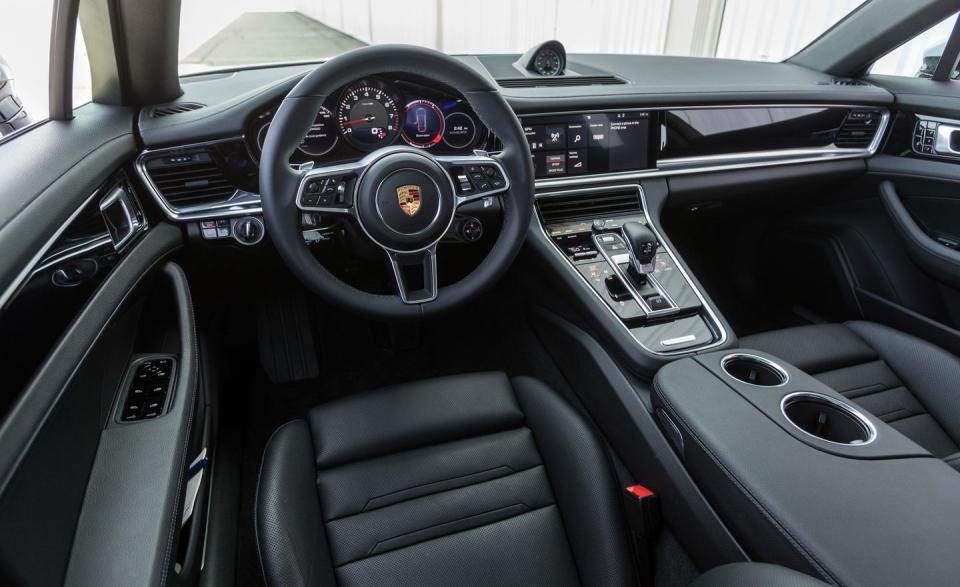2018 Porsche Panamera 4 and 4S Sport Turismo Bring Excellence without Relevance
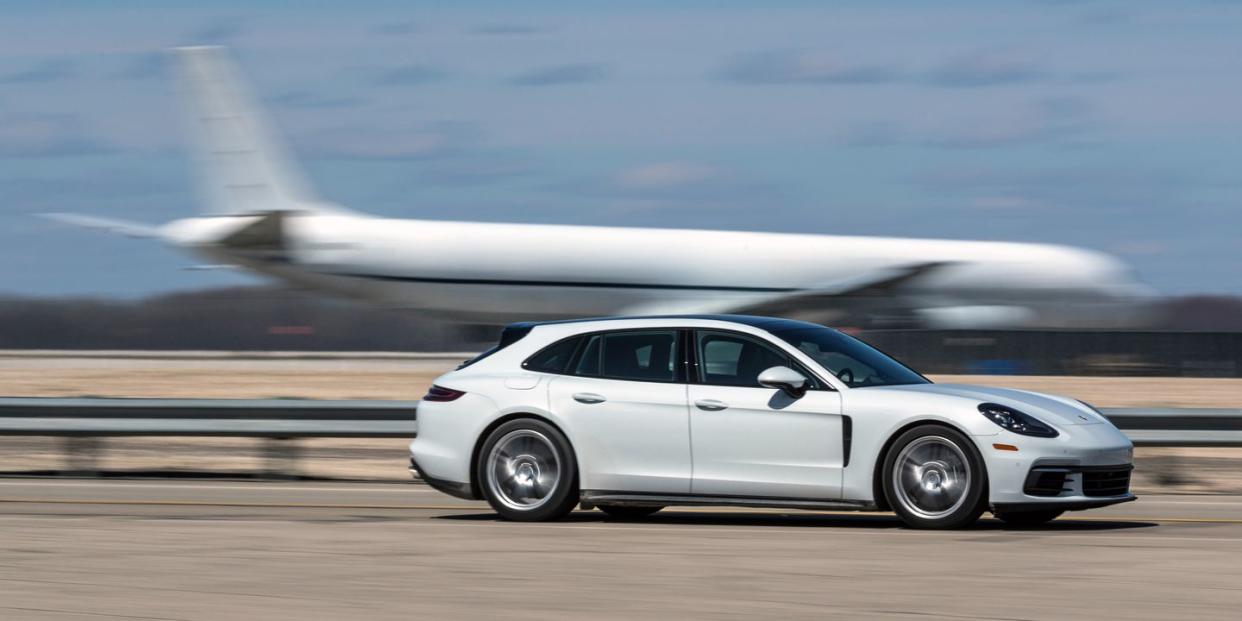
"Excellence" is a word that Porsche regularly uses in reference to itself. It's also a word Porsche owners like to throw around like one-dollar chips in a high-stakes poker game. It's even the name of an entire magazine dedicated to Porsche worship. Excellence may be a given when it comes to Porsches, but the question that arises with the Porsche Panamera 4 and 4S Sport Turismo is relevance.
In our SUV-crazed, crossover-loving, tall-car-addicted world, what is the point of this low-slung longroof thing? It was a big deal when Porsche introduced the Panamera as its first non-SUV four-door back in 2009. Now, the second generation of the broad-shouldered bruiser is available in neo-wagon form, and the world's reaction to it teeters on the hyphen in ho-hum.
Porsche's All-Wheel-Drive Wagon
The 4 means these particular Sport Turismos have all-wheel drive. (The digit is somewhat superfluous in that all Sport Turismos have all-wheel drive, but there's a rear-drive version of the standard Panamera, so wearing the 4 keeps the naming convention parallel between the two.) The 4 employs the base Panamera's 330-hp turbocharged 3.0-liter V-6, while the 4S is powered by a twin-turbo 2.9-liter V-6 rated at 440 horsepower. These are just a couple of rungs on what is now an 18-step ladder of Panamera models and variants.
The Sport Turismo part of the name means this is the extended-roof version of the Panamera.
Porsche doesn't call the Sport Turismo a station wagon, but that's kinda sorta what it is. Add some vinyl woodgrain and it could be the Panamera Country Squire. And frankly, that would be awesome.
The altered roofline doesn't radically expand cargo capacity-the 49 cubic feet with the rear seats folded isn't even two cubes greater than that of the regular Panamera-but it's accompanied by a larger rear hatch that extends down to the rear bumper and a flat load floor that makes the space somewhat more useful. Beyond that, the trailing portions of the rear door frames are slightly taller than those of the sedan, and that makes getting into and out of the back slightly easier. Finally, the Sport Turismo is also available with a three-person rear seat that makes this the first five-passenger Panamera. (Well, it was the first-the regular Panamera sedan now can be had with a three-across rear bench for 2019.)
The Sport Turismo, like the sedan, stretches 198.8 inches long over a 116.1-inch wheelbase. That's not only a lot larger than a 911, it's also longer than the Cayenne SUV-which is 193.6 inches long over a 114.0-inch wheelbase. The Cayenne, though, is 1.8 inches wider than the 76.3-inch-wide Panamera and, depending on the model, about 10 inches taller.
Porsche Attitude, Porsche Performance
Like the Panamera sedan, the Sport Turismo has an intimidating countenance. It's built for bold masters of the universe, not for meek apparatchiks; for veterans who have already been through free agency and know any NFL team would trade high draft picks to get them; for senior equity partners.
Given that, it would be nice if it were prettier. Like the standard Panamera, the Sport Turismo is a little anodyne and lacks a sense of delight, although we'd say it's the better-looking of the two. Also, in the Sport Turismo it's an itty bit easier to see out the rear-not that anything is likely to be gaining on you.
In 4S form, this car seems to spit in the eye of Newtonian physics. Using the launch-control system and letting the eight-speed dual-clutch automatic transmission handle the shifting, the Panamera 4S Sport Turismo took off as if it were being catapulted off the deck of an aircraft carrier. It ripped from zero to 60 mph in 3.5 seconds and through the quarter-mile in 12.0 seconds at 116 mph. The mere 4, meanwhile, needed all of 4.7 seconds to reach 60 mph and pulled a 13.4-second time slip in the quarter-mile.
The list of Porsches quicker than a 4S Sport Turismo is distinguished. Within the Panamera Sport Turismo range, there's the Panamera 4 E-Hybrid Sport Turismo, which supplements the twin-turbo 2.9-liter V-6 with an electric motor for a total output of 462 horsepower. Then there's the Panamera Turbo Sport Turismo, endowed with a twin-turbo 4.0-liter V-8 making 550 horsepower. And the 680-hp Panamera Turbo S E-Hybrid Sport Turismo adds a hybrid system to its twin-turbo V-8, and is cursed with a name so long it barely fits on the tailgate. It ran zero to 60 in 2.9 seconds and the quarter-mile in 11.1 seconds at 126 mph, making it the quickest station wagon since that red Ford Pinto was dropped from a helicopter over Chicago in The Blues Brothers. We haven't gotten to the track yet with a new-for-2019 Panamera GTS Sport Turismo, but we estimate that V-8 version is going to need only 3.5 seconds to get to 60 mph, too.
The V-6 in the 4S is making as much as 405 lb-ft of torque at only 1750 rpm. It's computerized to the point that it's probably smarter than the engineers who programmed it, and it feeds a PDK transmission that keeps up with it, IQ point for IQ point. And the all-wheel-drive system never allows the 275/35ZR-21 front and 315/30ZR-21 rear Pirelli P Zero PZ4 tires to emit even a chirp. And that's the problem. In the 4, this same AWD system, managing less torque delivered to tires that are smaller in diameter but just as wide, is predictably safe and steady, but it's the 4S that really feels constrained.
Never has a car so brilliantly quick been so antiseptic in its performance. The driver doesn't coax speed out of the 4S Sport Turismo so much as he or she submits a request and the computers then fulfill the order. It's like ordering a driving experience through Amazon using 1-Click.
No one expects a Panamera to deliver the raw speed of a 917 or the white-knuckle thrills of a 935, but there should be a feeling of connection to those glorious racers. Somehow the current 911s manage to do that.
Track Wizardry
With rear-wheel steering, Porsche Active Suspension Management (PASM), adaptive air springs, and the optional active anti-roll bars in the 4S, there's as much computerized wizardry built into the chassis as there is in the drivetrain. And on the skidpad, the results are astonishing: 1.05 g of lateral grip. In the 4, the active anti-roll bars are optional, and our test car was not so equipped. With its smaller Michelin Pilot Sport 4 tires, sized 275/40ZR-20 front and 315/35ZR-20 aft, it managed 0.98 g. The base model came to a stop from 70 mph in 147 feet, whereas the slightly heavier 4S needed 163 feet.
For all the Sport Turismo's measurable excellence on the track, the load of technology enabling it mediates the driver's interaction with the car. That leaves the Sport Turismo without the sense of immediately responsive reflexes that have been the essential element in every great Porsche's character. Further tempering this is the car's sheer size. The 911 has grown larger over its several generations, but it still rides on a wheelbase that's fully 19.6 inches shorter than the Panamera Sport Turismo's, and most versions are at least half a ton lighter. Physics is a cruel mistress, and she's particularly savage to the overgrown and obese. It's hard to argue that the base Panamera 4's 330 horses are insufficient for any real-world task, but in the pantheon of Porsche excellence, it barely earns the badge because it has been asked to carry too much baggage. Adding a third again as much horsepower makes the 4S more of a muscle machine, but it can't offset the sense of isolation.
Optional Standards
The revised interior of the second-generation Panamera is a step forward from the inscrutable blizzard of buttons that plagued the previous version, although it's still no exemplar of ergonomic excellence. The digital displays of the dash seem destined to set the paradigm for all Porsches as they evolve into their next iterations. The cabin is comfortable for four (five is a pinch), and there's room for a couple of medium-size dogs in the wayback.
The 2018 Panamera 4 Sport Turismo starts at $97,250, and the 4S at $110,250. Of course, no Panamera will leave a Porsche dealership without a thick layer of factory options. Nearly all those options are expensive, and a few of them ought to be standard but aren't. The $5400 Sport package, for instance, buys rear-wheel steering, the Sport Chrono package (which includes the launch-control system), and a sport exhaust system. All these things should be standard in every Porsche, yet Stuttgart charges extra for them. Our 4S had the active anti-roll bars with brake-based torque vectoring for another $5000. Add some miscellany, and the total came to $128,240. The 4 was optioned with rear-axle steering as a stand-alone item for $1620, and the Sport Chrono as a stand-alone package for $2270, but not the fancy anti-roll bars. It also had some options that make you ask, "Really, that costs extra on a six-figure car?" such as 14-way power front seats ($1780) and lane-change assist ($1060). Bottom line: $109,260. Giving up 110 horsepower and some pricey options saves enough to send your kid off to prep school in a new Toyota Corolla hatchback.
The Panamera Sport Turismo, in 4 or 4S form, is a Porsche that's easy to respect but not easy to love. There's plenty of excellence here, but one wonders about the relevance. Porsche's reputation rides on its sports cars, and its profits come from the SUVs. The Panamera was a big deal when it showed up eight years ago, but now it's the car that buyers walk past to get to the Macans and the Cayennes. It doesn't sell in huge numbers, and if it disappeared from Porsche's lineup, who would really care? As excellent as the new Panamera Sport Turismo is, it doesn't really matter.
('You Might Also Like',)
